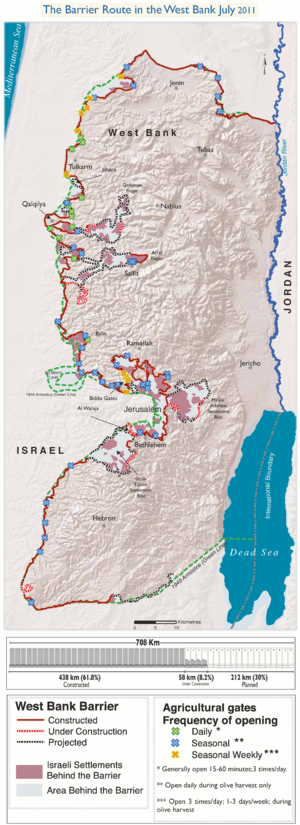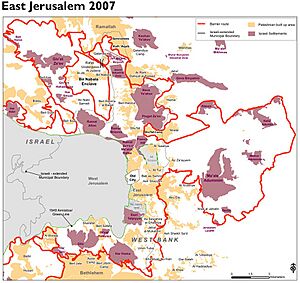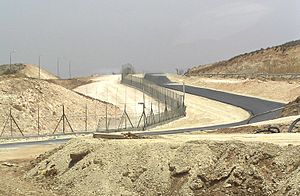Israeli West Bank barrier facts for kids
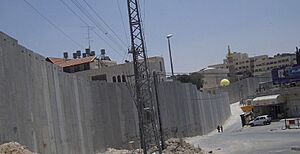
The Israeli West Bank barrier is a large wall and fence system built by Israel. It runs along the Green Line and also goes into parts of the West Bank.
Israel says it built the barrier to protect its people from violence and attacks. Palestinians, however, call it the "Wall of Apartheid" and say it separates people unfairly.
When finished, the barrier will be about 708 kilometers long. This is more than twice the length of the Green Line. Most of it (85%) is built inside the West Bank. This separates about 9% of the land and around 25,000 Palestinians from the rest of the Palestinian area.
Israel started building the barrier after a period of violence called the Second Intifada, which began in September 2000. At first, it was meant to be a temporary safety measure. But over time, it has become linked to ideas about a future border between Israel and the State of Palestine.
Many groups, including Palestinians and human rights organizations, have criticized the barrier. They say it looks like Israel wants to take Palestinian land, even though Israel says it's for security. Critics also argue that the barrier makes it harder for Palestinians to travel for work or daily life.
The International Court of Justice (ICJ) has said that building the barrier inside Palestinian territory goes against international law. In 2003, the United Nations General Assembly also voted that the barrier violates international law and should be removed.
The parts of the barrier that are concrete walls have become a canvas for graffiti art. This art often shows opposition to the barrier, Palestinian resistance, and messages about human rights.
Different Names for the Barrier
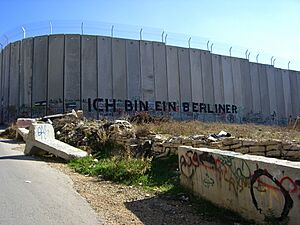
The barrier has several names, depending on who is talking about it.
In Hebrew, it is often called the "separation fence" or "security fence." These names focus on its purpose of separating people or providing safety.
In Arabic, it is usually called the "wall of apartheid" or "racial segregation wall." This name highlights the Palestinian view that the barrier unfairly separates people based on their background.
In English, news organizations like the BBC and The New York Times often use "barrier" or "separation barrier." The Israeli government uses "security fence." The International Court of Justice calls it a "wall" because of its physical structure. Some people also use "Apartheid Wall" to show their strong disapproval.
How the Barrier is Built
The Israeli Defense Forces describe the barrier as a "multi-layered obstacle." This means it's not just one type of structure.
Some parts of the barrier are tall concrete walls, reaching about 9 meters (30 feet) high. Other parts are made of a complex fence system. This system includes three fences with barbed wire on the outer two. The middle fence has special equipment to detect if someone tries to cross.
There is also an anti-vehicle ditch, patrol roads on both sides, and a smooth strip of sand. This sand helps track any intrusions. Where the fence system is used, there's usually an empty area about 60 to 100 meters (200 to 330 feet) wide. The concrete wall parts are about 3 meters (10 feet) thick.
Where the Barrier Runs
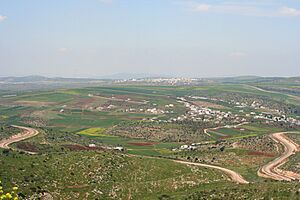
The barrier does not always follow the 1949 armistice line, also known as the "Green Line." In many places, it goes into the Israeli-occupied West Bank. It can go as far as 20 kilometers (12 miles) east of the Green Line.
This route includes several large Israeli settlements on the western side of the barrier. These include areas like East Jerusalem, the Ariel Bloc, Gush Etzion, and Maale Adumim.
About 8.5% of the West Bank area will be on the Israeli side of the barrier when it is finished. This means some Palestinian towns are almost completely surrounded by the barrier. Around 27,520 to 31,000 Palestinians will live on the Israeli side of the barrier. Another 124,000 Palestinians will be controlled and isolated by it. Also, about 230,000 Palestinians in Jerusalem will be on the West Bank side of the barrier.
Israel says that in some places, the land's shape (like hills or tall buildings) makes it impossible to build the barrier exactly on the Green Line and still be effective against attacks. However, the International Court of Justice says that in such cases, the barrier should only be built inside Israel.
The barrier's path has been changed several times after court challenges.
Is the Barrier Legal?
The barrier's legality has been a big topic of debate in the international community.
United Nations Views
In October 2003, the United Nations Security Council tried to pass a resolution saying the barrier was illegal where it went beyond the Green Line and should be removed. However, the United States vetoed this resolution.
In May 2004, the UN Security Council Resolution 1544 reminded Israel to follow international law. The United Nations General Assembly then asked the International Court of Justice (ICJ) to give its opinion on the barrier's legal status.
International Court of Justice Opinion
In July 2004, the International Court of Justice gave an advisory opinion. The ICJ said that "the construction of the wall, and its associated régime, are contrary to international law."
The Court advised that the barrier violates international law and should be taken down. It also said that Palestinian residents should be paid for any damage caused. The ICJ stated that Israel, as an occupying power, cannot claim that the people in the occupied territory are a "foreign" threat.
The Court also pointed out that the barrier's construction involved taking land, destroying homes, creating isolated areas, and limiting movement. This affects Palestinians' access to work, food, education, and healthcare, which violates international law.
Images for kids
-
Graffiti depicting U.S. President Donald Trump and Mark Zuckerberg on the Israeli barrier in Bethlehem, July 2018.
-
Graffiti paintings on the wall by British artist Banksy.
See also
 In Spanish: Barrera israelí de Cisjordania para niños
In Spanish: Barrera israelí de Cisjordania para niños


